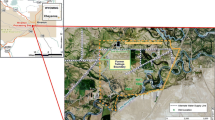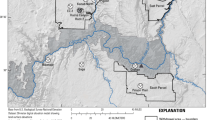Abstract
In Nevada, USA, the return of mine dewatering water (MDW) to the subsurface through rapid infiltration basins (RIBs) requires treatment if the quality exceeds the state’s Division of Environmental Protection (NDEP) Profile I reference values. However, a 2019 change to the Nevada Administrative Code allows discharge without treatment if the natural background groundwater solute concentrations are not exceeded. We developed a novel approach to demonstrate that groundwater will not be adversely affected by the untreated discharge of MDW. At the Cortez Gold Mine, dewatering will discharge water to the Grass Valley RIBs with 0.045 mg/L of As, exceeding the NV Profile I reference value (0.010 mg/L) and natural background (0.015 mg/L). A MODFLOW-SURFACT groundwater model incorporated empirical hydraulic conductivities to evaluate the extent to which changes in mound water depth and quality would occur. Modeling inputs were determined using column tests to assess SO4 leaching from the alluvium and batch tests to quantify As partition coefficients (KdAs = 8.9 L/kg) to the alluvium. The results indicated that Profile I will be met at all compliance wells due to dispersion and attenuation. The KdAs was also used to calculate the attenuation capacity of the alluvial mound water by adsorption (100-years), well beyond the 13-year operational span of the RIBs. Based on this analysis, and in conjunction with a similar analysis in the adjacent Crescent Valley, where 25 years infiltration of 0.045 mg/L As had not affected groundwater quality, the NDEP concurred that a dewatering water treatment plant was unnecessary. Overall, our analysis obviated construction of four treatment plants in the area and permitted direct discharge of mine dewatering water to the subsurface.
Resumen
El retorno del agua de desagote de minas (MDW) al subsuelo a través de las cuencas de infiltración rápida (RIBs) requiere tratamiento si la calidad excede los valores de referencia del Perfil I de la División de Protección Ambiental de Nevada (NDEP). Sin embargo, un cambio de 2019 en el Código Administrativo de Nevada (NAC) permite la descarga sin tratamiento siempre que no se superen las concentraciones de solutos en el agua subterránea de fondo natural. Desarrollamos un enfoque novedoso para demostrar que las aguas subterráneas no se verán afectadas por la descarga sin tratamiento de MDW con elevado contenido de As de origen natural. En la mina de oro de Cortez, NV USA, se descargará agua a las RIBs de Grass Valley con 0,045 mg/L de As, superando el valor de referencia de NV Profile I (0,010 mg/L) y el fondo natural (0,015 mg/L). Un modelo de aguas subterráneas MODFLOW-SURFACT incorporó conductividades hidráulicas empíricas para evaluar hasta qué punto se producirán cambios en la profundidad y la calidad del agua. Los datos de entrada del modelo se determinaron mediante pruebas de columna para evaluar la lixiviación de SO4 desde el aluvión y pruebas por lotes para cuantificar los coeficientes de partición de As (KdAs = 8,9 L/kg) al aluvión. Los resultados indicaron que el Perfil I se cumplirá en todos los pozos de cumplimiento debido a la dispersión y la atenuación. El KdAs también se utilizó para calcular la capacidad de atenuación del agua de los montículos aluviales mediante la adsorción (100 años), mucho más allá de la duración operativa de los RIBs (13 años). Sobre la base de este análisis, junto con un análisis similar en el adyacente Crescent Valley, donde 25 años de infiltración de 0,045 mg/L de As no han afectado a la calidad de las aguas subterráneas, el NDEP coincidió en que la construcción de una planta de tratamiento de aguas de desecación no proporcionaría ninguna protección adicional a las aguas subterráneas de Grass Valley.
Zusammenfassung
Die Rückführung von Grubensümpfungswasser (MDW) in den Untergrund über Schnellinfiltrationsbecken (RIBs) erfordert eine Behandlung, wenn die Wasserqualität die Referenzwerte des Profils I der Nevada Division of Environmental Protection (NDEP) überschreitet. Eine Änderung des Nevada Administrative Code (NAC) aus dem Jahr 2019 erlaubt jedoch die Einleitung ohne Behandlung, solange die natürlichen Hintergrundkonzentrationen gelöster Stoffe im Grundwasser nicht überschritten werden. Wir haben einen neuartigen Ansatz entwickelt, um nachzuweisen, dass das Grundwasser durch die unbehandelte Einleitung von MDW mit dem natürlicherweise vorkommenden erhöhten As nicht beeinträchtigt wird. In der Cortez Goldmine, NV USA, wird durch die Entwässerung Wasser mit einem As-Gehalt von 0,045 mg/L in die Grass Valley RIBs eingeleitet, was über dem Referenzwert des NV-Profils I (0,010 mg/L) und dem natürlichen Hintergrundwert (0,015 mg/L) liegt. Ein MODFLOW-SURFACT Grund¬wassermodell berücksichtigte empirische hydraulische Leitfähigkeiten, um zu bewerten, inwieweit sich die Tiefe und die Qualität des Grundwassers ändern werden. Die Inputs für die Modellierung wurden mit Hilfe von Säulentests zur Bewertung der SO4-Auswaschung aus dem Schwemmland und mit Hilfe von Batch-Tests zur Quantifizierung der As-Verteilungs¬koeffizienten (KdAs = 8,9 L/kg) im Schwemmland bestimmt. Die Ergebnisse zeigten, dass das Profil I an allen Konformitätsbrunnen aufgrund von Dispersion und Abschwächung eingehalten werden wird. Der KdAs wurde auch zur Berechnung der Dämpfungskapazität des Schwemmwassers durch Adsorption (100 Jahre) verwendet, was weit über die Betriebsdauer der RIBs (13 Jahre) hinausgeht. Auf der Grundlage dieser Analyse in Verbindung mit einer ähnlichen Analyse im angrenzenden Crescent Valley, wo eine 25-jährige Infiltration von 0,045 mg/L As keine Auswirkungen auf die Grundwasserqualität hatte, stimmte das NDEP zu, dass der Bau einer Wasseraufbereitungsanlage keinen zusätzlichen Schutz für das Grundwasser im Grass Valley bieten würde.
抽象的
如果水质超过内华达州环境保护局 (NDEP) Profile I参考值, 矿井 (山) 疏排水 (MDW) 的快速入渗盆地 (RIBs) 回灌就要先水处理. 但是, 在2019年, 内华达州行政法规 (NAC) 做出调整, 在不超过天然背景地下水溶质浓度的情况下, 允许不经处理排放矿井 (山) 疏排水 (MDW). 我们建立了一种新方法, 证明地下水不会受到未经处理的, 天然砷含量升高的矿井 (山) 疏排水 (MDW) 影响。美国内华达州Cortez金矿将向Grass Valley快速入渗盆地 (RIBs) 排放砷浓度0.045 mg/L的疏排水, 疏排水的砷浓度已超过内华达州Profile I参考值 (0.010 mg/L) 和天然背景值 (0.015 mg/L). 利用MODFLOW-SURFACT地下水模型与经验渗透系数相结合, 评价了水丘深度和水质量的变化程度. 模型输入参数的确定方法, 柱试验估算冲积层的SO4滤出, 批处理试验量化砷 (As) 在冲积层的分配系数 (KdAs=8.9 L/kg). 结果表明, 弥散和衰减作用将使所有验证井都满足Profile I参考标准. 同时, 利用砷分配系数 (KdAs) 计算了冲积层水丘的吸附 (100年) 衰减能力, 远超过快速入渗盆地 (RIBs) 运行期 (13年). 基于以上分析, 结合相邻的Crescent Valley 25年的砷0.045mg/L疏排水入渗回灌并没未影响地下水质量的类似情形, 华达州环境保护局 (NDEP) 同意了建立疏排废水处理厂并不能对Grass Valley地下水提供额外保护的观.










Similar content being viewed by others
References
ASTM (2007) D422-63. Standard Test Method for Particle-Size Analysis of Soils. ASTM International, West Conshohocken, PA, 2014. www.astm.org
ASTM (2014) D4874-95. Standard test method for leaching solid material in a column apparatus. ASTM International, West Conshohocken, PA, 2014. www.astm.org
Baes CF, Sharp RD (1983) A proposal for estimation of soil leaching and leaching constants for use in assessment models. J Environ Qual 12(1):17–28
Deutsch WJ (1997) Groundwater geochemistry fundamentals and applications to contamination. Lewis Publishers, USA
ESI (2011) Guide to Using Groundwater Vistas. Version 6, code documentation report, Environmental Simulations, Reinholds, PA
Fetter CW (1999) Contaminant Hydrogeology. Prentice Hall, NJ
Geomega, (2007) Cortez Hills Expansion Project Waste Rock Assessment. Report prepared for Cortez Gold Mines. Geomega Inc., Boulder CO
Geomega (2018) Cortez district groundwater analysis Crescent Valley, Nevada. Prepared for Barrick Cortez, Inc by Geomega Inc, Boulder, CO
Glover RE (1953) Flow from a test-hole located above groundwater level. In: Zangar CN (ed) Theory and problems of water percolation, U. S. Bureau of Reclamation, monograph no. 8, pp 69 -71
HGL (HydroGeoLogic) (2011) MODHMS/MODFLOW-SURFACT: A comprehensive MODFLOW-based hydrologic modeling system. Version 4.0 code documentation report, HydroGeoLogic, Reston, VA
NDEP (2018) Cortez District Groundwater Analysis Protocol. Nevada Div of Environmental Protection, Carson City
NDEP (2020) Approval of the Grass Valley Groundwater Analysis Report Grass Valley Infiltration Project Eureka and Lander Counties. Nevada Water Pollution Control Permit (WPCP) NEV2018107. Nevada Div of Environmental Protection, Carson City
Philip JR (1985) Approximate analysis of the borehole permeameter in unsaturated soil. Water Resour Res 21(7):1025–1033
Reynolds WD, Elrick DE, Topp GC (1983) A reexamination of the constant head well permeameter method for measuring saturated hydraulic conductivity above the water table. Soil Sci 139:172–180
Roy F, Krapac IG, Chou SFJ, Griffin RA. (1992) Batch-Type Procedures for Estimating Soil Adsorption of Chemicals. Prepared by the Illinois State Geological Survey, for the U.S. EPA, and published as EPA/530/SW-87/006
RPA (2018) Technical report on the Turquoise Ridge Mine, State of Nevada, USA. NI 43–101 report, Prepared for Barrick Gold Corp
SRK (2018) Groundwater flow model report Deep South Expansion Project, Crescent Valley, Nevada. Prepared for Barrick Cortez by SRK Consulting
Stephen DB, Neuman SP (1982) Vadose zone permeability tests: summary. ASCE J Hydraul Div 108(HY5):623–639
Xu M, Eckstein Y (1995) Use of weighted least-squares method in evaluation of the relationship between dispersivity and field Scale. Ground Water 33(6):905–908
Zangar CN (1953) Theory and problems of water percolation. U.S. Bureau of Reclamation, monograph no. 8, U.S. Dept of the Interior, Denver
Zheng C, Bennet GD (2002) Applied contaminant transport modeling, 2nd edn. Wiley, New York City
Author information
Authors and Affiliations
Corresponding author
Supplementary Information
Below is the link to the electronic supplementary material.
10230_2021_839_MOESM1_ESM.pdf
Appendix S1. 2016 Grass Valley RIB characterization. A collection of bore logs, groundwater chemistry and alluvial particle size distributions. (PDF 27948 kb)
Rights and permissions
About this article
Cite this article
Davis, A., Zhan, G., Sims, N. et al. Is Treatment of Mine Dewatering Water Necessary Prior to Rapid Infiltration Basin Recharge? A Case Study. Mine Water Environ 41, 58–73 (2022). https://doi.org/10.1007/s10230-021-00839-2
Received:
Accepted:
Published:
Issue Date:
DOI: https://doi.org/10.1007/s10230-021-00839-2




